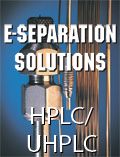HPLC/UHPLC
Participants in this discussion are Deanna Hurum of Dionex, Michael Dong of Genentech, and William Foley of Waters Corp.

High performance liquid chromatography (HPLC) has been the separation technique of choice for many years in analytical laboratories, while ultrahigh-pressure liquid chromatography (UHPLC) provides analytical chemists with another option for separating compounds with less solvent use and often higher throughput and resolution. Participants in this discussion are Deanna Hurum of Dionex, Michael Dong of Genentech, and William Foley of Waters Corp.
What’s new in HPLC and UHPLC?
Hurum:Column and instrument technology are constantly evolving. Column technology changes include smaller particle size stationary phases, expanded availability of monolith columns, and continued development of reversed-phase and HILIC column chemistries providing more options for improved control of separations. Many columns with unique specificity are now being offered, including mixed-mode columns with small particle size that offer additional opportunities for optimizing sample analysis. Recently there has been expanded use of detectors other than UV-vis, frequently within the same method, including the new generation of universal detectors. The capability of using two detectors in a series is a strong advantage in analysis of compounds that absorb weakly in the UV. Similarly, LC–MS has become more common in routine use and will continue to increase in popularity. Improved instrument and fitting design has reduced dead volumes, which is critical for UHPLC applications and serial detection schemes.
Dong:UHPLC systems with increased pressure limits of up to 18,000 psi, typically with much lower dispersion (extra-column bandbroadening), is the definitive modern trend and the new platform for HPLC. All of the major instrument vendors have some kind of UHPLC offering. Newer systems typically have higher pressure ratings and upper flow rates. Other new trends are small particle sizes, fused core particles, novel bonding chemistries, high temperature LC, parallel analysis, micro and nano LC, 2-D LC, LC chips, HILIC, and monoliths.
Foley:We have seen adoption of sub-2-µm LC particle technology across a wide variety of markets and applications increasing. However, the need for improved productivity and most recently, tightening equipment budgets, has led many more laboratories to qualify and adopt this technology. The benefits enabled by productivity enhancements and reduced solvent consumption and significantly lower waste generation have enhanced the attractiveness.
Which applications benefit the most from the advantages of UHPLC?
Hurum:Many HPLC applications that require high resolution take a significant amount of time and resources to complete. Examples include purity assays in food and pharmaceutical applications and peptide mapping in biopharmaceutical applications. In such applications, the number of peaks eluting in a given time are often quite large. By transferring these methods to UHPLC, significant throughput gains are accomplished. Resolution is maintained, or in some cases enhanced, and analysis times are dramatically reduced.
Dong:Virtually all applications can benefit from UHPLC, meaning that one can achieve good resolution in much less time or very high resolution of complex samples. UHPLC impacts positively in every application and industry, particularly in research, method development, LC–MS, high-throughput screening, pharm analysis, bioanalytical testing, and regulated analysis.
Foley:Applications that have benefited include discovery, method development, and impurity profiling, where improved resolution in combination with far higher throughput makes sub-2-µm-based LC methods an obvious solution to improve productivity. LC systems built on this technology are fast becoming the inlet of choice for MS detectors, regardless of vendor, due to the improved efficiency of the separation leading to increased ionization efficiencies and MS sensitivity enhancement. Also, with the desire to be more competitive and environmentally conscious, we have seen an increased interest in more routine analysis applications because of the improved throughput and reduced solvent consumption and waste generation.
Have users begun to transfer their methods from HPLC to UHPLC, particularly in applications such as pharmaceutical analysis?
Hurum:Pharmaceutical QA/QC laboratories are understandably conservative when transferring existing methods from HPLC to UHPLC, given the validation hurdles that they face. However, UHPLC is seeing greater use in method development, rapid method screening, and early research settings. Systems that are capable of both conventional HPLC and UHPLC have given greater flexibility to this process.
Dong:Yes, they have. Many have also “back-transferred” methods from UHPLC to HPLC, since UHPLC is a great tool for method development of new chemical entities. Many vendors offer programs to ease that “transfer.”
Foley:Yes, we have seen an increase in interest to transition methods from HPLC driven by the business benefits. We have seen a definite shift to sub-2-µm LC particle technology with new methods, and our customers are prioritizing the methods that make sense to transfer. Examples include analytical method screening.
Considering the state of the economy and last year’s acetonitrile shortage, what trends do you expect to see in 2010 for UHPLC?
Hurum:Continued development that incorporates solvent minimization should be expected. The acetonitrile shortage may have diminished, but the need to cut operational costs will continue across many industries. A switch to less expensive and readily available solvents may be effective for some applications; however, in many cases acetonitrile cannot be fully replaced. Smaller particle size stationary phases and shorter length columns will continue to be utilized to minimize solvent use in general.
Dong:I believe that the shortage and availability of acetonitrile are easing though pricing remains high. It makes sense to substitute acetonitrile with methanol particularly in prep LC. Nevertheless, acetonitrile offers many advantages over other solvents, such as higher efficiency, lower back pressure, and often better peak shapes. For instance, it would be difficult to replace acetonitrile in high-throughput screening.
Foley:The transition from 3- and 5-µm particle LC to sub-2-µm particle LC technology will continue in 2010. While capacity increases and the availability of acetonitrile improves, the costs will most likely not return to pre-shortage levels. The drive to improve operational efficiency and awareness that small particle technology can help reduce the environmental impact of an organization will help drive the transition.
If you are interested in participating in any upcoming Technology Forums please contact Group Technical Editor Steve Brown or Associate Editor Meg Evans for more information.
Characterizing Polyamides Using Reversed-Phase Liquid Chromatography
May 5th 2025Polyamides can be difficult to characterize, despite their use in various aspects of everyday life. Vrije Universiteit Amsterdam researchers hoped to address this using a reversed-phase liquid chromatography (RPLC)-based approach.
New Method Explored for the Detection of CECs in Crops Irrigated with Contaminated Water
April 30th 2025This new study presents a validated QuEChERS–LC-MS/MS method for detecting eight persistent, mobile, and toxic substances in escarole, tomatoes, and tomato leaves irrigated with contaminated water.
University of Tasmania Researchers Explore Haloacetic Acid Determiniation in Water with capLC–MS
April 29th 2025Haloacetic acid detection has become important when analyzing drinking and swimming pool water. University of Tasmania researchers have begun applying capillary liquid chromatography as a means of detecting these substances.
Prioritizing Non-Target Screening in LC–HRMS Environmental Sample Analysis
April 28th 2025When analyzing samples using liquid chromatography–high-resolution mass spectrometry, there are various ways the processes can be improved. Researchers created new methods for prioritizing these strategies.

.png&w=3840&q=75)

.png&w=3840&q=75)



.png&w=3840&q=75)



.png&w=3840&q=75)








